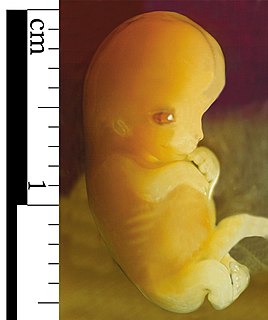
An embryo is the early stage of development of a multicellular organism. In general, in organisms that reproduce sexually, embryonic development is the part of the life cycle that begins just after fertilization and continues through the formation of body structures, such as tissues and organs. Each embryo starts development as a zygote, a single cell resulting from the fusion of gametes. In the first stages of embryonic development, a single-celled zygote undergoes many rapid cell divisions, called cleavage, to form a blastula, which looks similar to a ball of cells. Next, the cells in a blastula-stage embryo start rearranging themselves into layers in a process called gastrulation. These layers will each give rise to different parts of the developing multicellular organism, such as the nervous system, connective tissue, and organs...

Mangifera is a genus of flowering plants in the cashew family, Anacardiaceae. It contains approximately 69 species, with the best-known being the Common Mango. The center of diversity is in subtropical and tropical South Asia and Southeast Asia, while the highest number of species occur in India. They are generally canopy trees in lowland rainforests, reaching a height of 30–40 m (98–131 ft).

Nicotiana is a genus of herbaceous plants and shrubs in the family Solanaceae, that is indigenous to the Americas, Australia, south west Africa and the South Pacific. Various Nicotiana species, commonly referred to as tobacco plants, are cultivated as ornamental garden plants. N. tabacum is grown worldwide for production of tobacco leaf for cigarettes and other tobacco products.

Conium is one of more than 400 genera of flowering plants in the carrot family Apiaceae. As of December 2020, Plants of the World Online accepts six species.

Berberis, commonly known as barberry, is a large genus of deciduous and evergreen shrubs from 1–5 m (3.3–16.4 ft) tall, found throughout temperate and subtropical regions of the world. Species diversity is greatest in South America and Asia; Europe, Africa and North America have native species as well. The best-known Berberis species is the European barberry, Berberis vulgaris, which is common in Europe, North Africa, the Middle East, and central Asia, and has been widely introduced in North America. Many of the species have spines on the shoots and all along the margins of the leaves.
Casasia longipes is a species of plant in the family Rubiaceae. It is endemic to Jamaica.

Casasia is a genus of flowering plants in the family Rubiaceae. These shrubs or small trees occur on the Caribbean islands and in one case in Florida. Some of the ten accepted species were formerly placed elsewhere, e.g. in the related genip-tree genus (Genipa), in Gardenia or in Randia.
Scolosanthus is a genus of flowering plants in the coffee family, Rubiaceae.

Tolumnia Rafinesque, is a genus in the family Orchidaceae. Previously known as the "equitant Oncidiums", the species were segregated from the mega-genus Oncidium by Guido Braem in 1986. The plants are small, usually epiphytic, with small or absent pseudobulbs completely covered by leaves, which are triangular or circular in cross section and overlap each other at base to resemble a fan. The inflorescences arise between the leaf base and bear colorful, showy flowers. The labella are large, ornamented by variously shaped calli. The column bears prominent wings flanking the stigma. Dancing-lady orchid is a common name for some species in this genus.

Gardenieae is a tribe of flowering plants in the family Rubiaceae and contains about 586 species in 53 genera.

Tokai Park, previously known as "Tokai Forest", is a small wing, about 600 ha, of the greater Table Mountain National Park in Cape Town, South Africa. Tokai Park is made up of two sections: upper and lower Tokai Park. Lower Tokai Park is flat, and characterized by the threatened Cape Flats Sand Fynbos. Upper Tokai Park is on the slopes of Constantiaberg Mountain, and consists of conservation area as well as the Tokai Arboretum. Upper Tokai Park is characterized by Peninsula Granite Fynbos, Peninsula Sandstone Fynbos and Afromontane Forest and noted for its diversity.

Casasia clusiifolia, also called the sevenyear apple, is a species of plant belonging to the family Rubiaceae. It is common in Florida.
Casasia calophylla, is a species of plant belonging to the family Rubiaceae, it is native to Cuba.
Casasia domingensis is a plant native to the Dominican Republic, it is a part of the family Rubiaceae.
Casasia ekmanii is a plant belonging to the family Rubiaceae, it is native to Haiti.
Casasia haitensis is a species of plant that is native to Haiti. It belongs to the family Rubiaceae.
Casasia jacquinioides is a species of plant belonging to the family Rubiaceae.
Casasia nigrescens is a species of plant belonging to the family Rubiaceae. It is found in Cuba.
Casasia samuelssonii is a plant belonging to the family Rubiaceae. It is found in the Dominican Republic.









